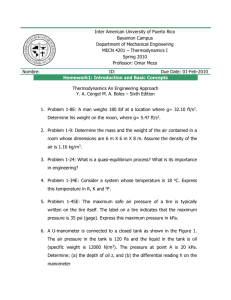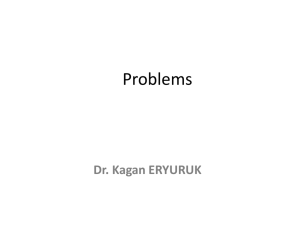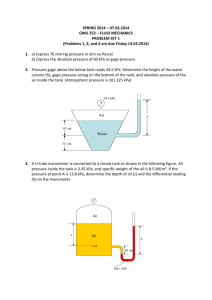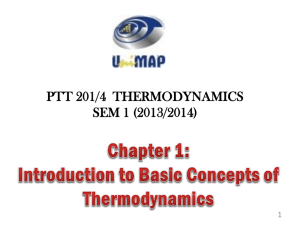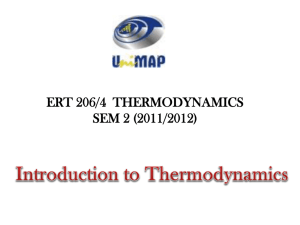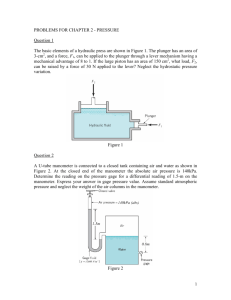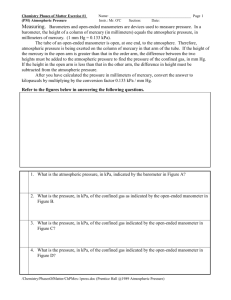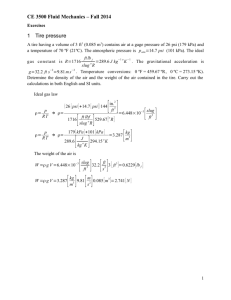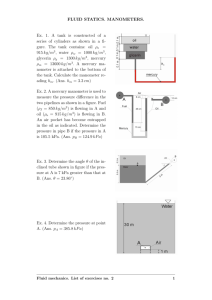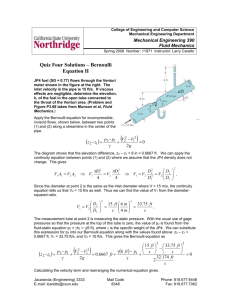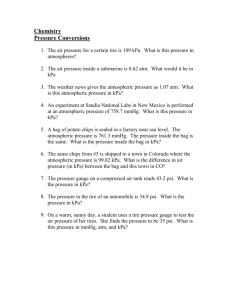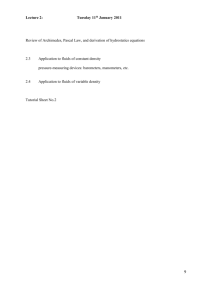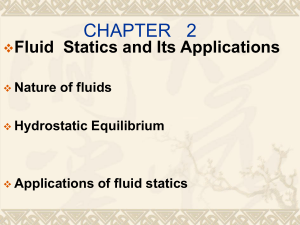CEGE1009_Sheet2_SOLN
advertisement
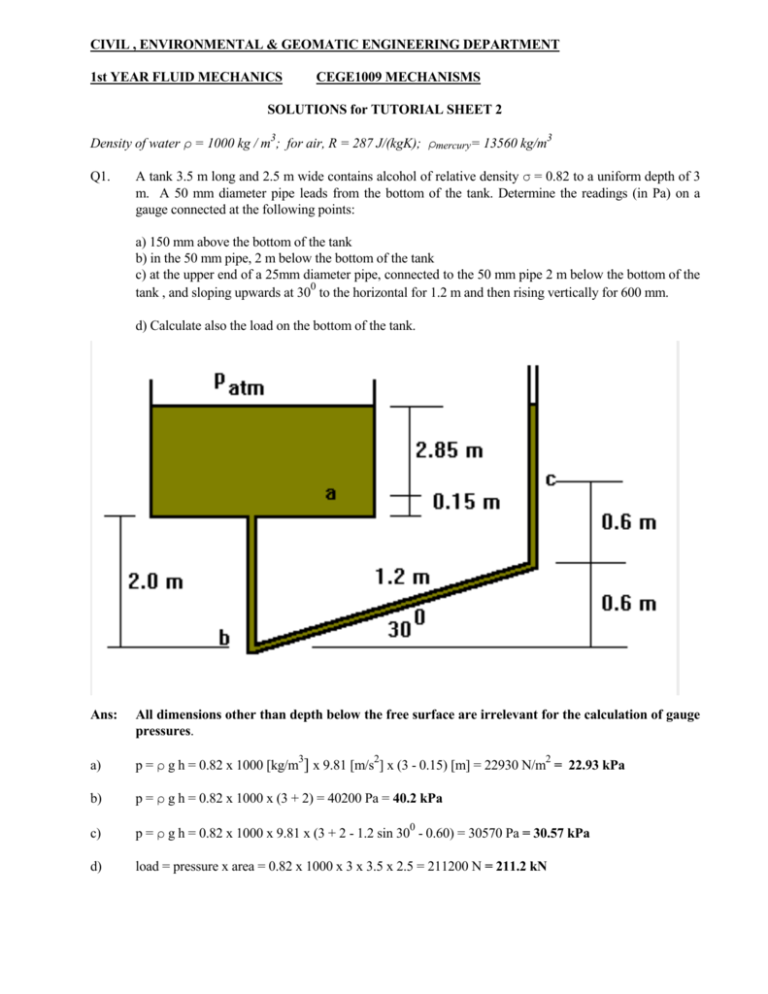
CIVIL , ENVIRONMENTAL & GEOMATIC ENGINEERING DEPARTMENT 1st YEAR FLUID MECHANICS CEGE1009 MECHANISMS SOLUTIONS for TUTORIAL SHEET 2 Density of water ρ = 1000 kg / m3; for air, R = 287 J/(kgK); ρmercury= 13560 kg/m3 Q1. A tank 3.5 m long and 2.5 m wide contains alcohol of relative density σ = 0.82 to a uniform depth of 3 m. A 50 mm diameter pipe leads from the bottom of the tank. Determine the readings (in Pa) on a gauge connected at the following points: a) 150 mm above the bottom of the tank b) in the 50 mm pipe, 2 m below the bottom of the tank c) at the upper end of a 25mm diameter pipe, connected to the 50 mm pipe 2 m below the bottom of the tank , and sloping upwards at 300 to the horizontal for 1.2 m and then rising vertically for 600 mm. d) Calculate also the load on the bottom of the tank. Ans: All dimensions other than depth below the free surface are irrelevant for the calculation of gauge pressures. a) p = ρ g h = 0.82 x 1000 [kg/m3] x 9.81 [m/s2] x (3 - 0.15) [m] = 22930 N/m2 = 22.93 kPa b) p = ρ g h = 0.82 x 1000 x (3 + 2) = 40200 Pa = 40.2 kPa c) p = ρ g h = 0.82 x 1000 x 9.81 x (3 + 2 - 1.2 sin 300 - 0.60) = 30570 Pa = 30.57 kPa d) load = pressure x area = 0.82 x 1000 x 3 x 3.5 x 2.5 = 211200 N = 211.2 kN Q2. An inverted U-tube manometer is used to measure the pressure drop across a sudden contraction in a horizontal stretch of water supply pipeline. If the actual pressure loss is found to be 294 Pa, calculate the reading on the inverted manometer if the fluid above the water is i) air, and ii) oil with density 800 kg/m3. Ans: Taking the pressure reference level [C - C'] to lie horizontally through the water - manometer fluid interface in upstream arm of the manometer (which lies at a higher level) Define h as the reference level height above the pipe centreline, r as the manometer reading. Then the pressure in the upstream arm is: P1 - ρwater g h Similarly, the pressure in the downstream arm is: P2 - ρwater g (h-r) - ρair/oil g r As these two points are connected through the manometer fluid, they must experience the same pressures. Hence: p1 - water g h = p2 - water g (h - r ) - air/oil g r p1 - p2 = ( water - air/oil ) g r For the case where the manometer fluid is air: r= p1 - p2 294 = = 0.030 m g ( water - air/oil ) 9.81 x (1000 - 1.29) For the case where the manometer fluid is oil: r= p1 - p2 294 = = 0.150 m g ( water - air/oil ) 9.81 x (1000 - 800) Q3. The figure below shows a special manometer arranged so that a difference in pressure between A and B will move the surface of separation in C. The cross-sectional areas of reservoirs A, B and the U-tube are given as 500 mm2, 800 mm2, and 70 mm2, and the densities of the liquids in A and B are 800 kg/m3 and 900 kg/m3 respectively. Find the pressure difference which will produce a rise in C of 60 mm. Ans: Initially there are a number of unknowns to be determined, namely, i) the actual pressure difference Δp between the free surfaces in reservoirs A and B, ii) the initial height h1 of the free surface in reservoir A above "Reference Level" C-C', iii) the initial height h2 of the free surface in reservoir B above "Reference Level" C-C', iv) the rise in level x in reservoir A when the pressure difference Δp is applied, and v) the rise in level y in reservoir B when the pressure difference Δp is applied. The changes in level, x and y, in reservoirs A and B when the pressure difference is applied can be determined by equating the volume of fluid displaced in tube C to the volumes displaced in reservoirs A and B: 60 . 10-3 .70 . 10-6 = x . 500 . 10-6 = y . 800 . 10-6 hence x = 0.0084 m and y = 0.00525 m Now considering the pressures in the two arms of the manometer at the level of the fluid interface, firstly before the pressure differential is applied: p + 1 g h1 = p + 2 g h2 and hence 1 h1 = 2 h2 ... then after the pressure has been added and the interface pushed upwards by 60 mm: p + 1 g ( h1 + x - 60 x 10-3 ) = p + p + 2 g ( h2 - y - 60 x 10-3 ) p = 1 g ( h1 + x - 60 . 10-3 ) - 2 g ( h2 - y - 60 . 10-3 ) = 800 x 9.81 x (0.0084 - 0.060) - 900 x 9.81 x ( - 0.00525 - 0.060) = 9.81(900 x 0.06525 - 800 x 0.0516 ) = 171.1Pa Q4. A rigid vessel of capacity 0.1 m3 contains air at gauge pressure, pgauge of 345 kPa and temperature 300 C. Atmospheric pressure is 752 mm mercury. Calculate the mass of air in the vessel. If atmos pressure rises to 765 mm mercury and temperature falls to -100C, calculate the new pgauge Ans: Consider first the atmospheric pressure in appropriate units: patm = mercury g h = 13560 [ kg 3 ] x 9.81[ m m s 2 ] x 0.752[m] = 105 Pa Hence the absolute pressure of the air in the vessel is: 105 + 345 x 103 Pa = 445 kPa, and the absolute temperature: 273 + 30 = 3030K The air in the container obeys the Perfect Gas law: pV = mRT (using absolute units). Hence: m= pV 445 x 103 x 0.1 = = 0.512 m RT 287 x 303 If the atmospheric pressure changes and the temperature falls to -100C, the mass and volume of air in the vessel must remain unaltered, and: p1 V p2 V p T 263 = : p 2 = 1 2 = 445 x 103 x Pa = 386.3 kPa m R T1 m RT2 303 T1 The new absolute atmospheric pressure is: 13560 x 9.81 x 0.765 = 101800 Pa and the new gauge pressure = p2 - patm = 386.3 - 101.8 = 284.5 kPa Q5. Assuming that atmospheric temperature decreases with increasing altitude at a uniform rate of 0.0065 K/m, determine the atmospheric pressure at an altitude of 7500 m if the temperature and pressure at sea level are 150 C and 101.5 kPa respectively. Ans: The air in the atmosphere is assumed to behave as a Perfect Gas - and is hence compressible. p -pg =- g = z RT but temperature varies with constant lapse rate λ = 0.0065 K/m such that: T = T0 - λ z p -pg = z R ( T 0 - z) Integrating: dp - g dz p g (T - z ) = gives : log e = log e 0 p R( T 0 - z ) p0 R T0 p z g = (1 ) R p0 T0 0 In this case, if atmospheric pressure at the ground is 101.5 kPa and the temperature 15 C (equivalent to 273 + 15 = 288 K), then at z = 7500 metres: 9.81/[287 x 0.0065] p = 101500 (1 - 0.0065 x 7500 / 288) = 38300 Pa [or 38.3 kPa ]
